|
 Humidicutis rosella Humidicutis rosella
SynonymsHygrocybe rosella
BiostatusPresent in region - Indigenous. Endemic
Images (click to enlarge)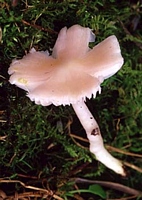
Caption: Humidicutis rosella
Owner: Kaimai Bush | 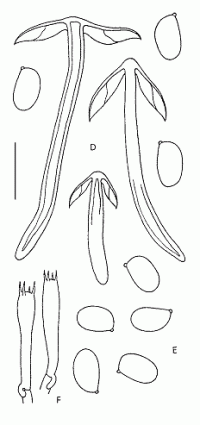
Caption: Fig. 45 Humidicutis rosella (Horak) Horak (D-F: PDD 27078, type):
D. basidiomes. E. spores. F. basidia | 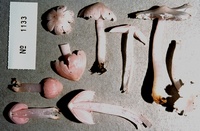
Caption: ZT1133
Owner: E. Horak: © Creative Commons Attribution-Noncommercial 3.0 New Zealand | 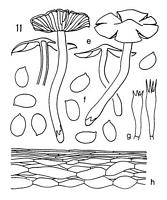
Caption: Hygrocybe rosella Hk. (type): e. carpophores. -f. spores.-g. basidia. -h. cuticle | 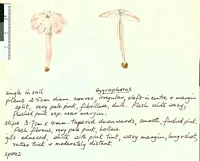
Caption: Watercolour
Owner: G.M. Taylor | 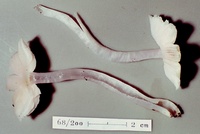
Caption: ZT68-200, Holotype
Owner: E. Horak: © Creative Commons Attribution-Noncommercial 3.0 New Zealand | 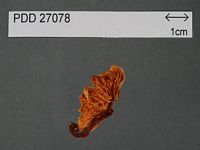
Caption: Dried type specimen
Owner: Herb PDD |
Article: Horak, E. (1973). Fungi Agaricini Novazelandiae I-V. Beihefte zur Nova Hedwigia 43: 200 p.
Description: Pileus 20-45 mm diam., conical when young becoming conico-convex or campanulate, radially splitting, pink, glabrous, dry, not striated. Lamellae adnexed or slightly emarginate-adnexed, pink, ventricose, gill edge concolorous, occasionally serrate. Stipe 35-80 x 4-6 mm, cylindric, equal, pink, dry, glabrous, hollow fragile, single. Context whitish. Odor and taste not distinctive. Chemical reactions on pileus: KOH and HCl- negative.
Spores 6.5-7.4-5 µm, ovoid, smooth, inamyloid. Basidia 28-40 x 7-8 µm, 4-spored. Cystidia absent. Cuticle consisting of repent, cylindric, not gelatinized hyphae (1-4 µm diam.) forming a cutis. Clamp connections absent.
Habitat: In soil under Podocarpus, Dacrydium, Weinmannia, etc. New Zealand.
Notes: This species is close to H. mavis (Stev.) from which it is distinguished by its pink colour and the smaller spores. Both species are similar in habit and lack clamp connections.
Article: Horak, E. (1990). Monograph of the New Zealand Hygrophoraceae (Agaricales). New Zealand Journal of Botany 28(3): 255-306 (http://www.rsnz.org/publish/abstracts.php).
Description: Pileus -60 mm, conical becoming conico-convex or papillate-campanulate, radially
splitting towards margin; pink, fading with age to isabelline-white; dry, glabrous
or innately fibrillose to silky, non-striate margin. - Lamellae 20-26 (1-3)
adnexed or almost free to emarginate-adnexed, ventricose, up to 7 mm wide; pink,
edges concolorous, entire or sometimes serrate. - Stipe 35-80 x 4-8 mm, cylindrical,
equal or subfusoid; pink; dry, glabrous to minutely fibrillose, waxy, hollow,
fragile, single. - Context whitish, brittle. - Odour and taste not distinctive.
- Chemical reactions on pileus: KOH and HCI - negative.
Spores 6.5-8 x 4-5 um, ovoid. - Basidia 28-40 x 6-8 um, -4 spored, with conspicuous
medallion-like clamp connection at basal septum. - Cystidia absent - Pileipellis
a cutis of repent cylindrical hyphae (2-4 um diam.), hyaline membrane not gelatinised,
occasionally encrusted with pigment, sometimes with oleiferous vessels in subcutis;
clamp connections absent on septa of cuticular hyphae (Pl. 1, Fig. 8).
Habitat: ECOLOGY: Scattered; saprobic on soil among litter in broadleaved-conifer forests
(Weinmannia, Metrosideros, Quintinia, Dacrydium, Agathis, Podocarpus).
March-June.
Distribution: DISTRIBUTION: NZ (NA, WL, STI).
Notes: Humidicutis rosella is distinguished by its permanently pink-coloured
basidiomes. Only in aged and weathered specimens does the pink tint fade to
whitish and then this taxon can be readily confused with the closely related
H. pura (Peck) Horak.
|